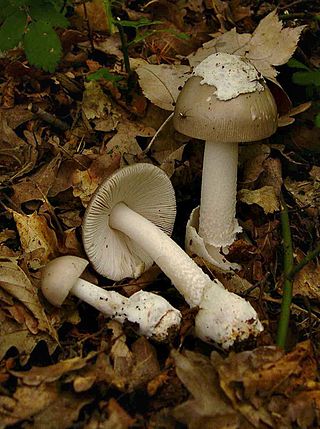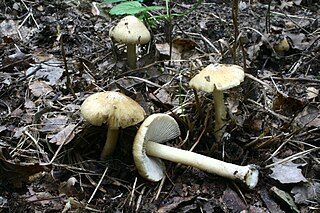
Pluteus cervinus, commonly known as the deer shield, deer mushroom, or fawn mushroom, is a species of fungus in the order Agaricales. Fruit bodies are agaricoid (mushroom-shaped). Pluteus cervinus is saprotrophic and fruit bodies are found on rotten logs, roots, tree stumps, sawdust, and other wood waste. It is common in Europe and eastern North America.

Tricholomopsis rutilans, commonly known as plums and custard, or red-haired agaric, is a species of gilled mushroom found across Europe and North America.

Gymnopus dryophilus is a mushroom commonly found in temperate woodlands of Europe and North America. It is generally saprophytic, but occasionally also attacks living wood. It belongs to section Levipedes of the genus, being characterized by a smooth stem having no hairs at the base. Until recently it was most frequently known as Collybia dryophila.

Russula claroflava, commonly known as the yellow russula, yellow swamp russula or yellow swamp brittlegill, is a basidiomycete mushroom of the genus Russula. It is found in wet places under birch and aspen woodlands across Europe and North America. It has a yellow cap, white gills and stipe and bruises grey. It is mild-tasting and regarded as good to eat.

Russula sanguinaria, commonly known as the bloody brittlegill or rosey russula, is a strikingly coloured mushroom of the genus Russula, which has the common name of brittlegills. It is bright blood-red, inedible, and grows in association with coniferous trees. It was previously widely known as Russula sanguinea.

Lactarius pyrogalus, commonly known as the fire-milk lactarius, is a species of inedible mushroom in genus Lactarius. It is greyish and differentiated from other grey Lactarius by its widely spaced, yellow gills. It is found on the forest floor in mixed woodland, especially at the base of hazel trees.

Lactarius glyciosmus, commonly known as the coconut scented milk cap, is a semi-edible mushroom in the genus Lactarius. It is typically coloured a greyish lilac, with the sometimes hollow stem a little lighter coloured than the cap. It has crowded, decurrent gills, and smells strongly of coconuts. Mycorrhizal, it can be found growing in soil at the base of birch trees in Europe.

Ampulloclitocybe clavipes, commonly known as the club-foot or club-footed clitocybe, is a species of gilled mushroom from Europe and North America. The grey brown mushrooms have yellowish decurrent gills and a bulbous stalk, and are found in deciduous and conifer woodlands. Although considered edible, disulfiram-like reactions have been reported after consumption of alcohol after eating this mushroom.

Russula fragilis, commonly known as the fragile russula, or fragile brittlegill, is a species of mushroom of the genus Russula, whose members are commonly known as brittlegills. It is a small, fragile, long stemmed, and variably coloured brittlegill, found in mixed forests, and woods in Europe, Asia, and North America.

Amanita vaginata, commonly known as the grisette or the grisette amanita, is an edible mushroom in the fungus family Amanitaceae. The cap is gray or brownish, 5 to 10 centimetres in diameter, and has furrows around the edge that duplicate the gill pattern underneath. Unlike many other Amanita mushrooms, A. vaginata lacks a ring on the stem.

Amanita daucipes is a species of fungus in the family Amanitaceae of the mushroom order Agaricales. Found exclusively in North America, the mushroom may be recognized in the field by the medium to large white caps with pale orange tints, and the dense covering of pale orange or reddish-brown powdery conical warts on the cap surface. The mushroom also has a characteristic large bulb at the base of its stem with a blunt short rooting base, whose shape is suggestive of the common names carrot-footed lepidella, carrot-foot amanita, or turnip-foot amanita. The mushroom has a strong odor that has been described variously as "sweet and nauseous", or compared to an old ham bone, or soap. Edibility is unknown for the species, but consumption of species belonging to Amanita subgroup Lepidella is risky.

Cystoderma carcharias, is a species of agaric in the fungal family Agaricaceae. It has a widespread distribution, and has been collected in coniferous forests and grasslands in Asia, Europe, North America, and the subantarctic islands. In the field, fruit bodies are characterized by a pink cap up to 6 cm (2.4 in) broad, a well-developed ring on the stem, and an unpleasant odour.

Mycena epipterygia is a species of fungus in the family Mycenaceae of mushrooms commonly found in Europe. It is commonly known as yellowleg bonnet or yellow-stemmed mycena. The species is saprotrophic and its appearance is quite variable. For example, a number of members of the genus Mycena, some parts of the fungus are bioluminescent, including in this species, the mycelium. Mycena nivicola has been suggested as a separate species name for the Western variety.

Lactarius subflammeus, commonly known as the orange milk cap, is a species of fungus in the family Russulaceae. It is found in western North America in the late summer and fall and is especially common in the Pacific Northwest, where it grows on the ground near conifers like pine and spruce. The brightly colored fruit bodies, which are slimy or sticky, have scarlet caps when young that soon fade to brilliant orange. The stem—typically longer than the width of the cap—is also bright orange but the gills are whitish. The mushroom secretes a whitish latex when it is cut or injured.

Lactarius affinis, commonly known as the kindred milk cap, is a species of milk-cap mushroom in the family Russulaceae. It is found northeastern North America, where it fruits in the summer and fall, and is common in the Great Lakes region. Its fruit bodies have medium to large, slimy dull yellow or brownish caps. Although not considered poisonous, it is unpalatable because of its highly acrid taste.

Cortinarius traganus, also known as the gassy webcap or lilac conifer cortinarius, is a basidiomycete mushroom of the genus Cortinarius. The mushrooms are characterized by their lilac color, the rusty-brown gills and spores, and rusty-brown flesh in the stem.

Cortinarius anomalus, also known as the variable webcap, is a basidiomycete fungus of the genus Cortinarius. It produces a medium-sized mushroom with a grayish-brown cap up to 5 cm (2 in) wide, gray-violet gills and a whitish stem with pale yellow belts below. The mushroom grows solitarily or in scattered groups on the ground in deciduous and coniferous forests. It is found throughout the temperate zone of the northern hemisphere.

Inosperma cookei, commonly known as the straw fibrecap, is a species of mushroom in the family Inocybaceae. It was first described in 1892 by Giacomo Bresadola, and is named in honour of Mordecai Cubitt Cooke. The species is found in Europe, Asia, and North America. It produces small mushrooms of an ochre colour, with a prominent umbo, fibres on the cap and a distinctive bulb at the base of the stem. It grows from soil in mixed woodland, and is encountered in summer and autumn, though is not common. Ecologically, it feeds through use of ectomycorrhiza. Inosperma cookei has been described as both toxic and non-toxic, but either way, is not advised for consumption.

Collybia tuberosa, commonly known as the lentil shanklet or the appleseed coincap, is an inedible species of fungus in the family Tricholomataceae, and the type species of the genus Collybia. Like the two other members of its genus, it lives on the decomposing remains of other fleshy mushrooms. The fungus produces small whitish fruit bodies with caps up to 1 cm (0.4 in) wide held by thin stems up to 5 cm (2.0 in) long. On the underside of the cap are closely spaced white gills that are broadly attached to the stem. At the base of the stem, embedded in the substrate is a small reddish-brown sclerotium that somewhat resembles an apple seed. The appearance of the sclerotium distinguishes it from the other two species of Collybia, which are otherwise very similar in overall appearance. C. tuberosa is found in Europe, North America, and Japan, growing in dense clusters on species of Lactarius and Russula, boletes, hydnums, and polypores.

Rhodocollybia butyracea, commonly known as the buttery collybia, is a species of fungus in the mushroom family Omphalotaceae. It has a number of subspecies.




















